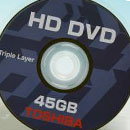Format Wars: CRACKED Looks at the NextGen DVD Players


If you're a fan of bitter and protracted format wars between enormous consumer electronics conglomerates, you're in for a treat this summer. The next generation of DVD players have arrived and are now battling it out for your dollars, your living room, and yes, your love.
These spanking brand new DVD players are capable of containing significantly more information than a regular DVD â€" enough information to store high definition pictures for today' modern televisions. Or, alternately, six times the amount of low definition pictures, for those consumers that need to store 52 hours of grainy pornography. Which, it turns out, is a surprisingly powerful demographic.
There' only one catch. There are two different versions of this marvelous new technology. They're called HD-DVD and Blu-Ray. And yes, you guessed it: they're incompatible.
If all of this sounds familiar, it should. The same thing happened in the 1980' when the VHS format (backed by JVC, the Catholic Church and Paul McCartney) duked it out with the Beta format (backed by Sony, the Soviet Union, and John Lennon) for supremacy in the home video market. As we all know, it was the VHS format that would emerge victorious, and gain dominance in our living rooms. Sony was forced to start making VHS machines, and a distraught John Lennon, bedridden since the loss, passed away soon after.
Toshiba's HD-DVD vs. Sony's Blu-Ray
This time around we have Toshiba, who back the HD-DVD format, and Sony (Lifetime Format War record: 0-1) back again, this time with Blu-Ray. Both claim to have the superior product, and haven't been willing to compromise on a middle ground. So, like two fat children on a teeter-totter, both sides are gambling that their collected market weight will loft their opponent perilously in the air. And inevitably, like two fat children on a teeter-totter, there' only one possible outcome: big, fat, wet tears.

Whatever the outcome for the companies involved, for the consumers a format war is almost certainly bad news. It' practically guaranteed that one of the formats will die off completely, leaving anyone who supported the losing format with a $1000 turd sitting in their living room. And unless you're a connoisseur of post-modern shock art, or have very specific sexual preferences, a turd has no business in your living room.
The sudden appearance of living room turds — the metaphorical ones - is exactly what happened in the Beta vs VHS wars. After the VHS gained dominance, owning a Beta machine, aside from being completely useless, was a sign of technological backwardness and a source of great embarrassment. It would remain that way until the turn of the century, when the emergence of hipsters gave Beta a new lease on cool.

Which brings us to the present day. Consumers who have purchased a fancy new high definition television will want to make the most of it. High Definition cable and satellite sources are now available, but it turns out that watching Deal or No Deal in high definition feels somewhat lacking, oddly. What we need are high definition movies. This is where HD-DVD and Blu-Ray come in.
How They Work
So how do these new formats work? In basic concept, they're both quite similar. Both formats use blue lasers, instead of the red laser used in a regular DVD player.
It' this blue laser where the Blu-Ray gets its name, and also, interestingly, where the HD-DVD does not get its name.
Blue light has a smaller wavelength than the normal red light used in DVD players. This means a blue laser can read smaller pits on the disc. Smaller pits mean you can squeeze more of them on to a single disc. i.e. if the pits on a regular DVD are women, the pits on a Blu-Ray disc or HD-DVD would be much smaller - possibly Asian - women. And when talking about storage formats, more women equals more storage space. Just like in real life.
The major differences between the two formats is how much they can store and how much they cost. The HD-DVD format can hold 15 GB, and the Blu-Ray weighs in at 25 GB. The size advantage of the Blu-Ray is offset by the higher costs to manufacture them. HD-DVD players are expected to start at $400 to $500. Blu-Ray players are expected to initially cost around $800 to $1000. A similar difference in the cost of the discs is expected as well.
Which One Do I Buy?
So with all the tediously boring technical details out of the way, the question remains: who' going to win? If you had to buy one of these machines today, which is the best choice? Cracked approached top marketing scientist Dr. Steven Farsen to get an expert opinion.

According to Dr. Farsen, the winner will probably turn out to be whichever format has the least-ridiculous name. Going back to our favorite example, the unimaginatively named VHS format won out over Beta not because of superior technology or marketing, but because Sony was foolish enough to advertise that their product was second-best right in its fucking name.

If that sounds stupid, remember that consumers are at heart, incredibly stupid. Seriously. These are the same people that bought Furbees. So, because the name "Blu-Ray" sounds kind of stupid, and because whoever named the HD-DVD had no illusions regarding the intelligence of their consumer base, and simply named their product "High Definition DVD", the HD-DVD format will win this format war handily.
Congratulations HD-DVD!

_____________
Chris Bucholz is a regular contributor to CRACKED.com, and writer of the hilarious blog Robotman!